fuel filter Alfa Romeo 166 2006 Owner handbook (in English)
[x] Cancel search | Manufacturer: ALFA ROMEO, Model Year: 2006, Model line: 166, Model: Alfa Romeo 166 2006Pages: 272, PDF Size: 4.17 MB
Page 78 of 272
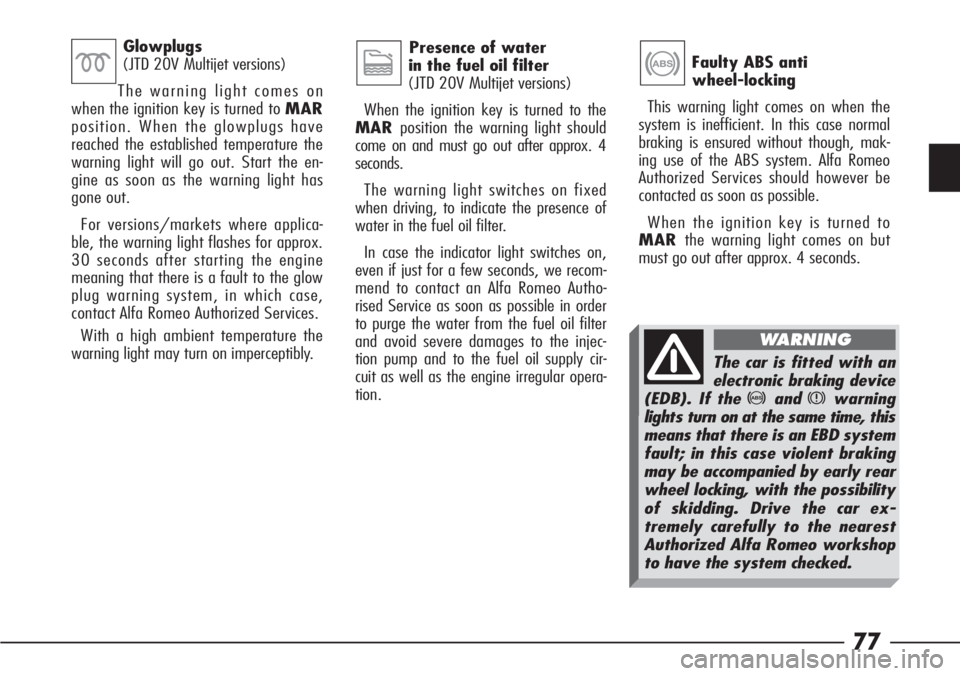
77
Faulty ABS anti
wheel-locking
This warning light comes on when the
system is inefficient. In this case normal
braking is ensured without though, mak-
ing use of the ABS system. Alfa Romeo
Authorized Services should however be
contacted as soon as possible.
When the ignition key is turned to
MARthe warning light comes on but
must go out after approx. 4 seconds.>
Presence of water
in the fuel oil filter
(JTD 20V Multijet versions)
When the ignition key is turned to the
MARposition the warning light should
come on and must go out after approx. 4
seconds.
The warning light switches on fixed
when driving, to indicate the presence of
water in the fuel oil filter.
In case the indicator light switches on,
even if just for a few seconds, we recom-
mend to contact an Alfa Romeo Autho-
rised Service as soon as possible in order
to purge the water from the fuel oil filter
and avoid severe damages to the injec-
tion pump and to the fuel oil supply cir-
cuit as well as the engine irregular opera-
tion.
c
Glowplugs
(JTD 20V Multijet versions)
The warning light comes on
when the ignition key is turned to MAR
position. When the glowplugs have
reached the established temperature the
warning light will go out. Start the en-
gine as soon as the warning light has
gone out.
For versions/markets where applica-
ble, the warning light flashes for approx.
30 seconds after starting the engine
meaning that there is a fault to the glow
plug warning system, in which case,
contact Alfa Romeo Authorized Services.
With a high ambient temperature the
warning light may turn on imperceptibly.
m
The car is fitted with an
electronic braking device
(EDB). If the
>andxwarning
lights turn on at the same time, this
means that there is an EBD system
fault; in this case violent braking
may be accompanied by early rear
wheel locking, with the possibility
of skidding. Drive the car ex-
tremely carefully to the nearest
Authorized Alfa Romeo workshop
to have the system checked.
WARNING
Page 126 of 272
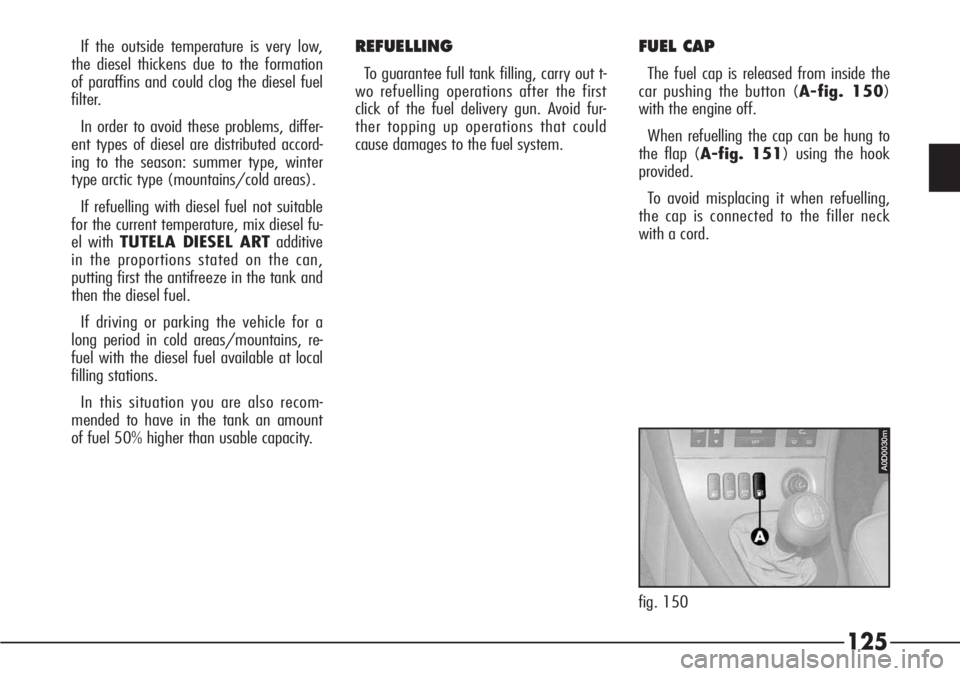
125
If the outside temperature is very low,
the diesel thickens due to the formation
of paraffins and could clog the diesel fuel
filter.
In order to avoid these problems, differ-
ent types of diesel are distributed accord-
ing to the season: summer type, winter
type arctic type (mountains/cold areas).
If refuelling with diesel fuel not suitable
for the current temperature, mix diesel fu-
el with TUTELA DIESEL ARTadditive
in the proportions stated on the can,
putting first the antifreeze in the tank and
then the diesel fuel.
If driving or parking the vehicle for a
long period in cold areas/mountains, re-
fuel with the diesel fuel available at local
filling stations.
In this situation you are also recom-
mended to have in the tank an amount
of fuel 50% higher than usable capacity.FUEL CAP
The fuel cap is released from inside the
car pushing the button (A-fig. 150)
with the engine off.
When refuelling the cap can be hung to
the flap (A-fig. 151) using the hook
provided.
To avoid misplacing it when refuelling,
the cap is connected to the filler neck
with a cord.
A0D0030m
fig. 150
REFUELLING
To guarantee full tank filling, carry out t-
wo refuelling operations after the first
click of the fuel delivery gun. Avoid fur-
ther topping up operations that could
cause damages to the fuel system.
Page 149 of 272
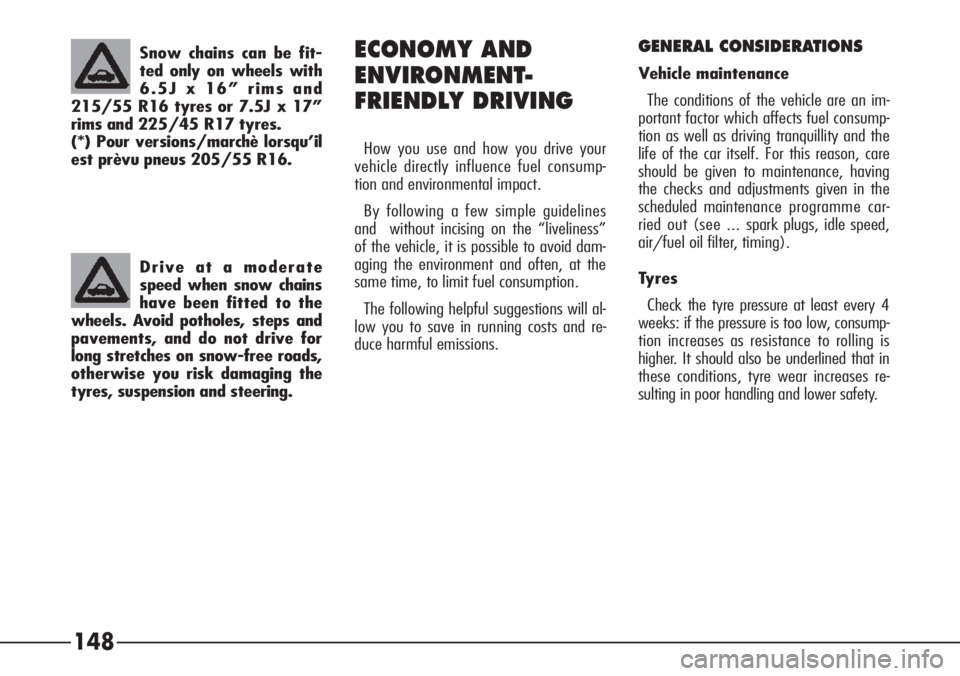
148ECONOMY AND
ENVIRONMENT-
FRIENDLY DRIVING
How you use and how you drive your
vehicle directly influence fuel consump-
tion and environmental impact.
By following a few simple guidelines
and without incising on the “liveliness”
of the vehicle, it is possible to avoid dam-
aging the environment and often, at the
same time, to limit fuel consumption.
The following helpful suggestions will al-
low you to save in running costs and re-
duce harmful emissions.
GENERAL CONSIDERATIONS
Vehicle maintenance
The conditions of the vehicle are an im-
portant factor which affects fuel consump-
tion as well as driving tranquillity and the
life of the car itself. For this reason, care
should be given to maintenance, having
the checks and adjustments given in the
scheduled maintenance programme car-
ried out (see ... spark plugs, idle speed,
air/fuel oil filter, timing).
Tyres
Check the tyre pressure at least every 4
weeks: if the pressure is too low, consump-
tion increases as resistance to rolling is
higher. It should also be underlined that in
these conditions, tyre wear increases re-
sulting in poor handling and lower safety. Drive at a moderate
speed when snow chains
have been fitted to the
wheels. Avoid potholes, steps and
pavements, and do not drive for
long stretches on snow-free roads,
otherwise you risk damaging the
tyres, suspension and steering.
Snow chains can be fit-
ted only on wheels with
6.5J x 16” rims and
215/55 R16 tyres or 7.5J x 17”
rims and 225/45 R17 tyres.
(*) Pour versions/marchè lorsqu’il
est prèvu pneus 205/55 R16.
Page 190 of 272
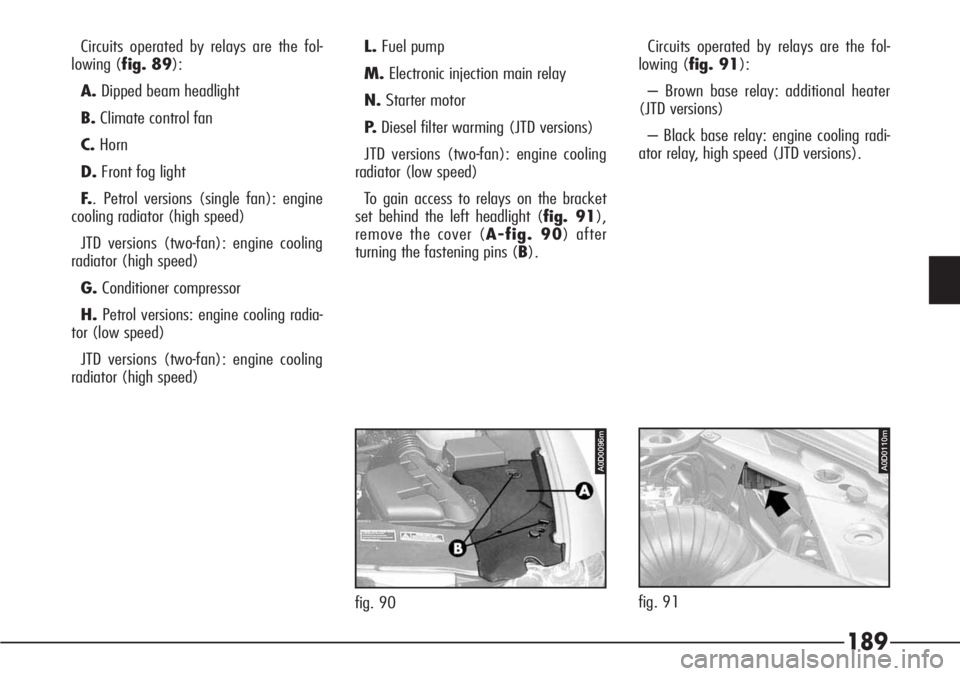
189
Circuits operated by relays are the fol-
lowing (fig. 89):
A.Dipped beam headlight
B.Climate control fan
C.Horn
D.Front fog light
F.. Petrol versions (single fan): engine
cooling radiator (high speed)
JTD versions (two-fan): engine cooling
radiator (high speed)
G.Conditioner compressor
H.Petrol versions: engine cooling radia-
tor (low speed)
JTD versions (two-fan): engine cooling
radiator (high speed)L.Fuel pump
M.Electronic injection main relay
N.Starter motor
P.Diesel filter warming (JTD versions)
JTD versions (two-fan): engine cooling
radiator (low speed)
To gain access to relays on the bracket
set behind the left headlight (fig. 91),
remove the cover (A-fig. 90) after
turning the fastening pins (B).Circuits operated by relays are the fol-
lowing (fig. 91):
– Brown base relay: additional heater
(JTD versions)
– Black base relay: engine cooling radi-
ator relay, high speed (JTD versions).
A0D0096m
fig. 90
A0D0110m
fig. 91
Page 193 of 272
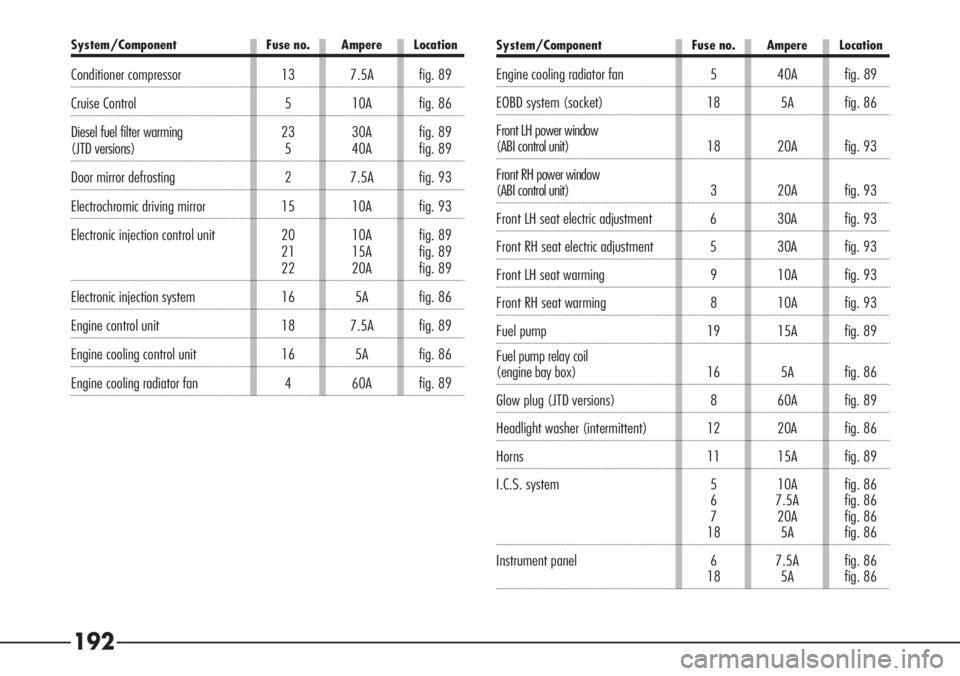
192
System/Component Fuse no. Ampere Location
Conditioner compressor 13 7.5A fig. 89
Cruise Control 5 10A fig. 86
Diesel fuel filter warming 23 30Afig. 89
(JTD versions) 5 40Afig. 89
Door mirror defrosting 2 7.5A fig. 93
Electrochromic driving mirror 15 10A fig. 93
Electronic injection control unit 20 10A fig. 89
21 15A fig. 89
22 20A fig. 89
Electronic injection system 16 5A fig. 86
Engine control unit 18 7.5A fig. 89
Engine cooling control unit 16 5A fig. 86
Engine cooling radiator fan 4 60A fig. 89
System/Component Fuse no. Ampere Location
Engine cooling radiator fan 5 40A fig. 89
EOBD system (socket) 18 5A fig. 86
Front LH power window
(ABI control unit) 18 20Afig. 93
Front RH power window
(ABI control unit) 3 20Afig. 93
Front LH seat electric adjustment 6 30A fig. 93
Front RH seat electric adjustment 5 30A fig. 93
Front LH seat warming 9 10A fig. 93
Front RH seat warming 8 10A fig. 93
Fuel pump 19 15A fig. 89
Fuel pump relay coil
(engine bay box) 16 5Afig. 86
Glow plug (JTD versions) 8 60A fig. 89
Headlight washer (intermittent) 12 20A fig. 86
Horns 11 15A fig. 89
I.C.S. system 5 10A fig. 86
6 7.5A fig. 86
7 20A fig. 86
18 5A fig. 86
Instrument panel 6 7.5A fig. 86
18 5A fig. 86
Page 206 of 272
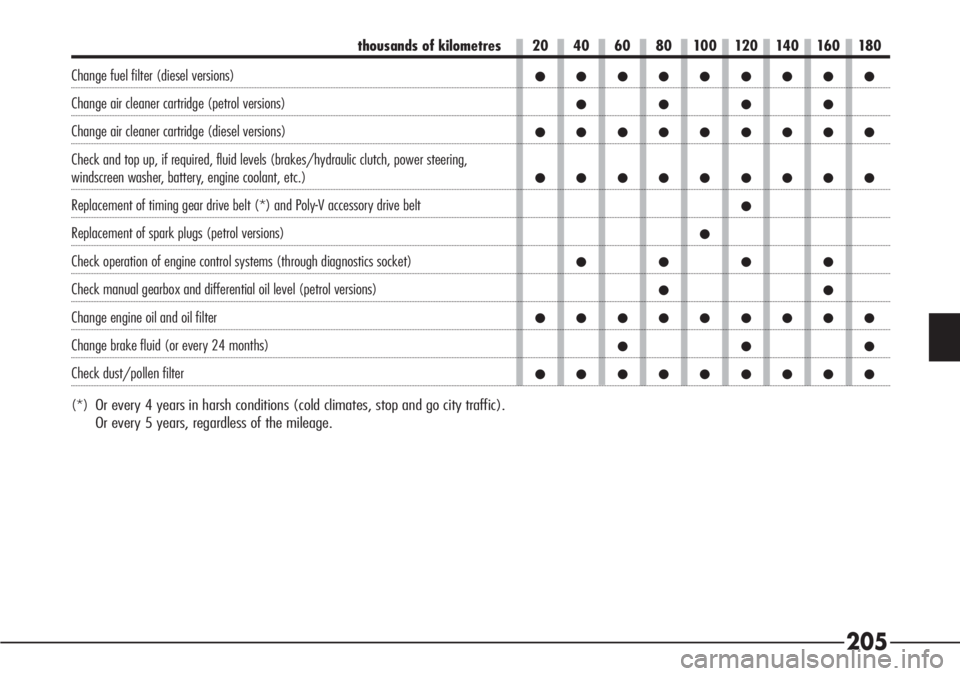
205
thousands of kilometres 20 40 60 80 100 120 140 160 180
Change fuel filter (diesel versions)•••••••••
Change air cleaner cartridge (petrol versions)••••
Change air cleaner cartridge (diesel versions)•••••••••
Check and top up, if required, fluid levels (brakes/hydraulic clutch, power steering,
windscreen washer, battery, engine coolant, etc.)•••••••••
Replacement of timing gear drive belt (*) and Poly-V accessory drive belt•
Replacement of spark plugs (petrol versions)•
Check operation of engine control systems (through diagnostics socket)••••
Check manual gearbox and differential oil level (petrol versions)••
Change engine oil and oil filter •••••••••
Change brake fluid (or every 24 months)•••
Check dust/pollen filter•••••••••
(*)Or every 4 years in harsh conditions (cold climates, stop and go city traffic).
Or every 5 years, regardless of the mileage.
Page 207 of 272
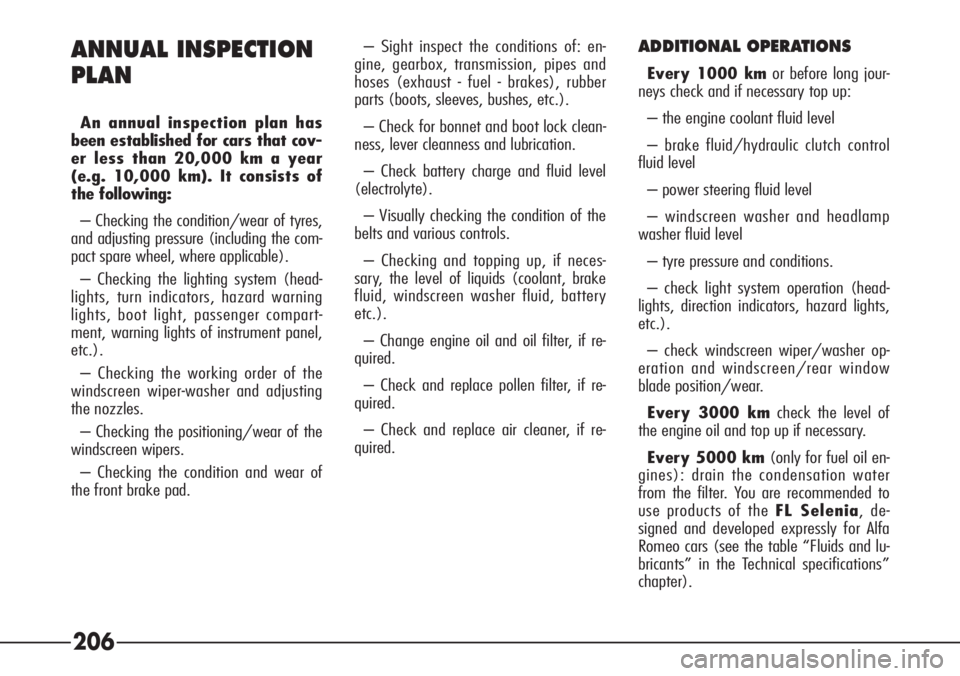
206 ANNUAL INSPECTION
PLAN
An annual inspection plan has
been established for cars that cov-
er less than 20,000 km a year
(e.g. 10,000 km). It consists of
the following:
– Checking the condition/wear of tyres,
and adjusting pressure (including the com-
pact spare wheel, where applicable).
– Checking the lighting system (head-
lights, turn indicators, hazard warning
lights, boot light, passenger compart-
ment, warning lights of instrument panel,
etc.).
– Checking the working order of the
windscreen wiper-washer and adjusting
the nozzles.
– Checking the positioning/wear of the
windscreen wipers.
– Checking the condition and wear of
the front brake pad.– Sight inspect the conditions of: en-
gine, gearbox, transmission, pipes and
hoses (exhaust - fuel - brakes), rubber
parts (boots, sleeves, bushes, etc.).
– Check for bonnet and boot lock clean-
ness, lever cleanness and lubrication.
– Check battery charge and fluid level
(electrolyte).
– Visually checking the condition of the
belts and various controls.
– Checking and topping up, if neces-
sary, the level of liquids (coolant, brake
fluid, windscreen washer fluid, battery
etc.).
– Change engine oil and oil filter, if re-
quired.
– Check and replace pollen filter, if re-
quired.
– Check and replace air cleaner, if re-
quired.
ADDITIONAL OPERATIONS
Every 1000 kmor before long jour-
neys check and if necessary top up:
– the engine coolant fluid level
– brake fluid/hydraulic clutch control
fluid level
– power steering fluid level
– windscreen washer and headlamp
washer fluid level
– tyre pressure and conditions.
– check light system operation (head-
lights, direction indicators, hazard lights,
etc.).
– check windscreen wiper/washer op-
eration and windscreen/rear window
blade position/wear.
Every 3000 kmcheck the level of
the engine oil and top up if necessary.
Every 5000 km(only for fuel oil en-
gines): drain the condensation water
from the filter. You are recommended to
use products of the FL Selenia, de-
signed and developed expressly for Alfa
Romeo cars (see the table “Fluids and lu-
bricants” in the Technical specifications”
chapter).
Page 208 of 272
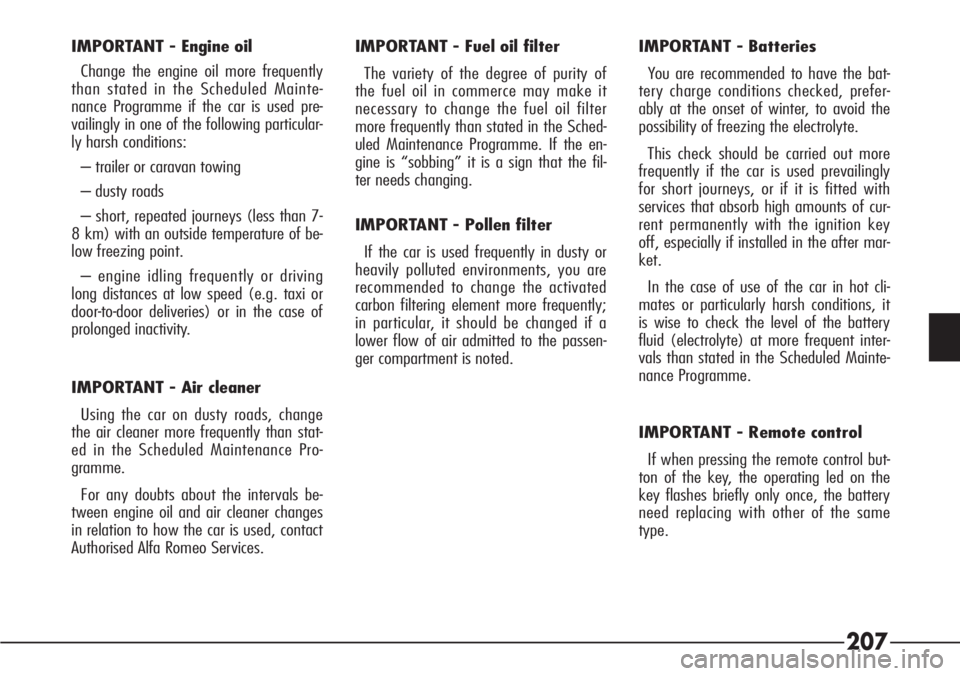
207
IMPORTANT - Engine oil
Change the engine oil more frequently
than stated in the Scheduled Mainte-
nance Programme if the car is used pre-
vailingly in one of the following particular-
ly harsh conditions:
– trailer or caravan towing
– dusty roads
– short, repeated journeys (less than 7-
8 km) with an outside temperature of be-
low freezing point.
– engine idling frequently or driving
long distances at low speed (e.g. taxi or
door-to-door deliveries) or in the case of
prolonged inactivity.
IMPORTANT - Air cleaner
Using the car on dusty roads, change
the air cleaner more frequently than stat-
ed in the Scheduled Maintenance Pro-
gramme.
For any doubts about the intervals be-
tween engine oil and air cleaner changes
in relation to how the car is used, contact
Authorised Alfa Romeo Services.IMPORTANT - Fuel oil filter
The variety of the degree of purity of
the fuel oil in commerce may make it
necessary to change the fuel oil filter
more frequently than stated in the Sched-
uled Maintenance Programme. If the en-
gine is “sobbing” it is a sign that the fil-
ter needs changing.
IMPORTANT - Pollen filter
If the car is used frequently in dusty or
heavily polluted environments, you are
recommended to change the activated
carbon filtering element more frequently;
in particular, it should be changed if a
lower flow of air admitted to the passen-
ger compartment is noted.IMPORTANT - Batteries
You are recommended to have the bat-
tery charge conditions checked, prefer-
ably at the onset of winter, to avoid the
possibility of freezing the electrolyte.
This check should be carried out more
frequently if the car is used prevailingly
for short journeys, or if it is fitted with
services that absorb high amounts of cur-
rent permanently with the ignition key
off, especially if installed in the after mar-
ket.
In the case of use of the car in hot cli-
mates or particularly harsh conditions, it
is wise to check the level of the battery
fluid (electrolyte) at more frequent inter-
vals than stated in the Scheduled Mainte-
nance Programme.
IMPORTANT - Remote control
If when pressing the remote control but-
ton of the key, the operating led on the
key flashes briefly only once, the battery
need replacing with other of the same
type.
Page 237 of 272
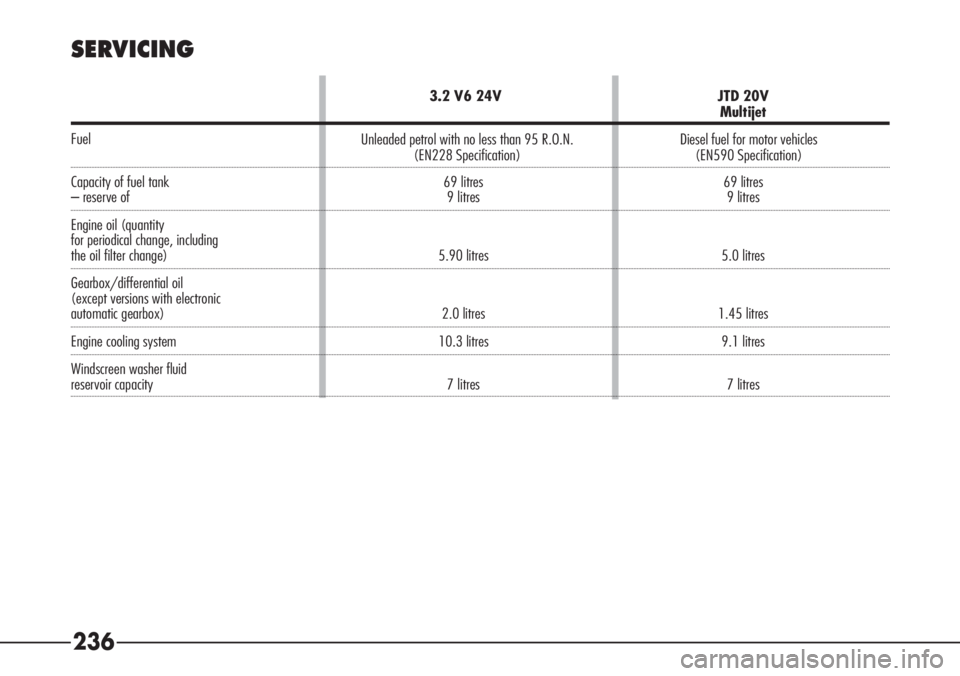
236 SERVICING
Unleaded petrol with no less than 95 R.O.N.
(EN228 Specification)Diesel fuel for motor vehicles
(EN590 Specification) 3.2 V6 24V JTD 20V
Multijet
Fuel
Capacity of fuel tank 69 litres 69 litres– reserve of 9 litres 9 litres
Engine oil (quantity
for periodical change, including
the oil filter change) 5.90 litres 5.0 litres
Gearbox/differential oil
(except versions with electronic
automatic gearbox) 2.0 litres 1.45 litres
Engine cooling system 10.3 litres 9.1 litres
Windscreen washer fluid
reservoir capacity 7 litres 7 litres
Page 264 of 272

263
ABS (system) ..............................114
Additional heater ..............................91
Air bags, front and side ....................50
Air cleaner ....................................218
Air conditioner ................................83
Air conditioning ................................80
Alfa Romeo CODE system ..................16
Alfa Romeo I.C.S. system ................14
Ashtray ..........................................99
ASR (system) ................................117
At the filling station ........................124
Automatic fuel cut-off switch
and power supply ......................127
Battery ......................................219
Body maintenance..........................225
Boot ............................................105
Boot light......................................185Brake Assist ............................116-141
Brakes..........................................241
Bulb replacement ....................165-181
Car maintenance......................201
Carrying children safety ....................45
Central locking ................................29
Changing the bulb
- Bulb types ........................165-166
- General instructions ..................165
Child safety ....................................30
Child safety device (doors) ................45
Cigar lighter ....................................98
CO
2emissions ................................241
Coin holder......................................98
Controls ..........................................93
Correct use of the car..............133
Courtesy light ................................101Cruise Control ..................................64
Dashboard ....................................68
Data plates....................................232
Diesel filter....................................219
Dimensions ..................................234
Direction indicators ..........................59
Door lights ....................................102
Doors ............................................28
Dust/pollen filter ......................90-219
Electronic alarm system ..................22
Electronic control units ....................223
Emission control devices ..................129
Engine ..........................................235
Engine codes – Body versions ..........233
Engine coolant temperature gauge ......74
Engine oil consumption ..................236
ALPHABETICAL INDEX